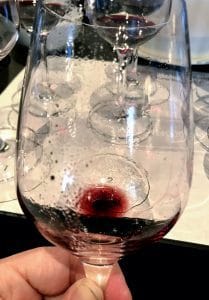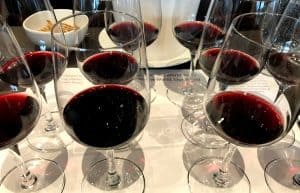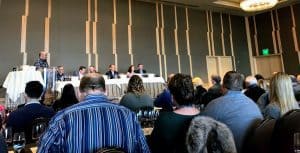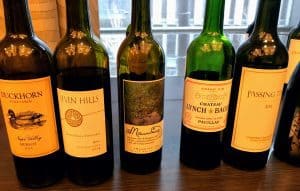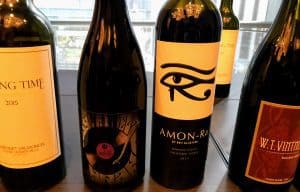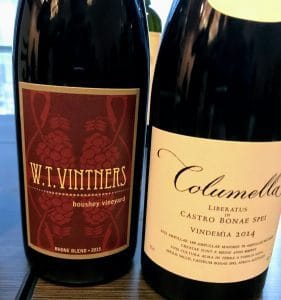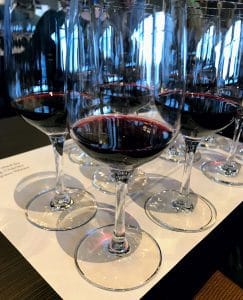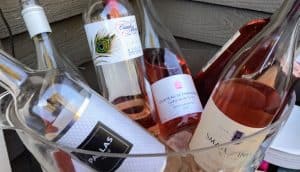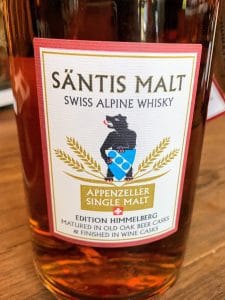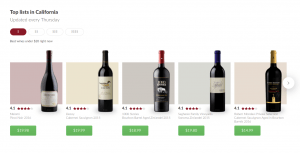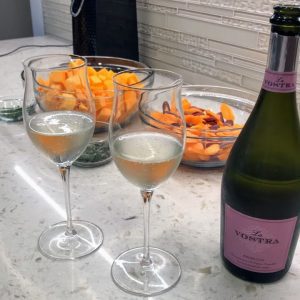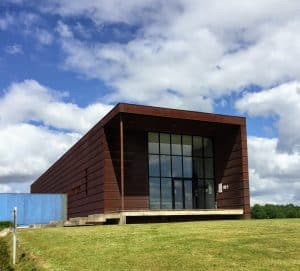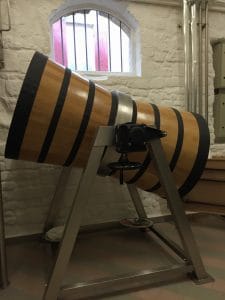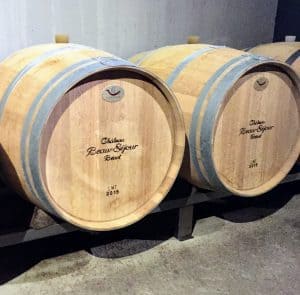
After covering the 2017 Bordeaux futures offers of Clos de l’Oratoire, Ch. Monbousquet, Ch. Quinault l’Enclos and Ch. Fonplegade in our first visit to St. Emilion, we return now to look at the offers for the Premier Grand Cru Classé ‘B’ estates of Ch. Beau-Séjour Bécot, Ch. Canon-la-Gaffelière and Ch. Canon as well as the Grand Cru Classé estate of Ch. La Dominique.
While we are 10 entries deep into this series, first time visitors are always well-advised to check out the the first Bordeaux Futures 2017 post covering the offers of Palmer, Valandraud, Fombrauge and Haut-Batailley that gives an overview of what we are looking for here at SpitBucket in deciding on whether to Buy or Pass on these 2017 offers.
You can also check out the links at the bottom to see other offers that we have reviewed in this series.
Now onto the offers.
Ch. Beau-Séjour Bécot (St. Emilion)
Some Geekery:
The Ancient Romans were one of the first to cultivate vines in what is now Beau-Séjour Bécot more than 2000 years ago. During the Middle Ages the property came under the stewardship of the monks of Saint-Martin de Mazerat who also managed what is now Ch. Canon.
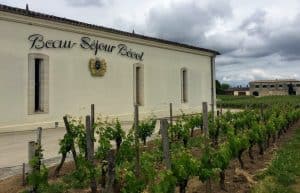
The exterior of Beau-Séjour Bécot.
Stephen Brook notes in The Complete Bordeaux that eventually the property came under the ownership of the Lord of Camarsacs. In 1722 when the daughter of one of the lords married into the Carles de Figeac family, the estate was given to the new couple as dowry.
One of their descendants, General Jacques de Carles renamed the property Beauséjour (meaning “good stay”) in 1787. By the early 1800s, Clive Coates describes in Grand Vins that the large estate was ranked highly in prestige in St. Emilion just behind Ch. Belair, Troplong-Mondot, Ch. Canon and Ausone.
In 1869, the estate was split between the heirs of Pierre-Paulin Ducarpe with his son getting the half that is today Beau-Séjour Bécot and his daughter, who married into the Duffau-Lagarosse family, inheriting the part that is now Ch. Beauséjour Duffau-Lagarrosse. In 1955 both estates were classified as Premier Grand Cru Classé ‘B’.
The Bécot family, who already owned Ch. La Carte, purchased Beau-Séjour in 1969–affixing their name and later expanding it with their holdings at La Carte and acquiring the nearby Trois Moulins vineyard. However, the use of these other vineyard plots in the Grand Vin of Beau-Séjour Bécot was not previously approved by the governing authority of the St. Emilion classification so in 1986 the estate was demoted to Grand Cru Classé.
With the aid of consultant Michel Rolland, the Bécots worked 10 years to improve the vineyard quality of the new parcels and agreed not to use any parcels deemed inferior by the authorities for the Grand Vin. When the 1996 classification was released, Ch. Beau-Séjour Bécot was restored to its Premier Grand Cru Classé ‘B’ ranking.
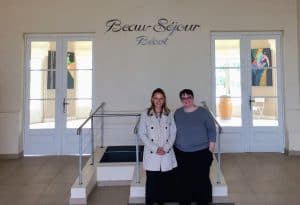
The author touring the estate with Caroline Bécot.
Today the property is still in the hands of the Bécot family with Juliette Bécot managing the estate alongside Julien Barthe. In 2018, Michel Rolland left as consultant and was replaced by Thomas Duclos.
The 2017 vintage is a blend of 80% Merlot, 15% Cabernet Franc and 5% Cabernet Sauvignon. Around 6000 cases are produced each year.
Critic Scores:
93-96 Wine Spectator (WS), 93-95 Wine Enthusiast (WE), 93-94 James Suckling (JS), 92-94 Wine Advocate (WA), 91-93 Vinous Media (VM), 93-95 Jeff Leve (JL), 91-94 Jeb Dunnuck (JD)
Sample Review:
Coming from an incredible terroir located on the limestone plateau just outside the village, the 2017 Château Beau-Séjour Bécot is a medium-bodied, refined, incredibly elegant 2017 that offers awesome notes of crème de cassis, crushed violets, earth, and a saline-like minerality. Winemaker Thomas Duclos compares the 2017 to 2012, saying the wines will put on weight in barrel as well in bottle. Their 2017 is a fresh, vibrant wine and has tons of potential. The blend is 80% Merlot, 15% Cabernet Franc and the rest Cabernet Sauvignon, with the Merlot brought in from the 14th to the 22nd of September, and the Cabernets on October 28 and 29. The wine will spend 16 months in 65% new French oak, with the balance in stainless steel, amphora, and larger oak. — Jeb Dunnuck, JebDunnuck.com
Offers:
Wine Searcher 2017 Average: $58
JJ Buckley: $59.94 + shipping (no shipping if picked up at Oakland location)
Vinfolio: No offers yet.
Spectrum Wine Auctions: No offers yet.
Total Wine: $59.97 (no shipping with wines sent to local Total Wine store for pick up)
K&L: $59.99 + shipping (no shipping if picked up at 1 of 3 K & L locations in California)
Previous Vintages:
2016 Wine Searcher Ave: $74 Average Critic Score: 93 points
2015 Wine Searcher Ave: $77 Average Critic Score: 93
2014 Wine Searcher Ave: $59 Average Critic Score: 91
2013 Wine Searcher Ave: $57 Average Critic Score: 90
Buy or Pass?
Compared to its peers in the Premier Grand Cru Classé tier, the wines of Beau-Séjour Bécot have always struck me as solid (if not slightly underrated) values.
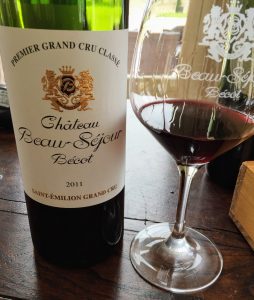
The 2011 was very tight in 2016 and is still slowly starting to come out of its shell.
This makes me think that the 2017 is a wine that will probably need a good 10+ years itself.
My esteem for the estate rose even more during my 2016 visit to the region where I was also introduced to Juliette Bécot’s very delicious Joanin Bécot label from her Cotes de Castillon estate. Both the 2012 and 2015 of that label have been screaming good values under $30 that I eagerly seek out at retail stores and on restaurant wine lists.
While the 2017 will be a compelling buy for many Bordeaux fans, my only hitch is that my past experiences with the wines of Beau-Séjour Bécot have taught me that these wines need time in the cellar and rarely deliver much pleasure early in their life. While that is great for “cellar investment” years like 2015/2016, that is not my objective for futures buying with the 2017s.
So I will Pass on this offer even though it is a solid buy. However, I will certainly be buying some of the 2017 Joanin Bécot when it hits retail stores in 2019/2020.
Ch. Canon-la-Gaffelière (St. Emilion)
Some Geekery:
Canon-la-Gaffelière is a relatively young estate that was previously known as Canon Boitard (after an early 19th century owner) and La Gaffelière-Boitard with La Gaffelière coming from the medieval term for “lepers” and denoting the area’s previous history as part of manor grounds for a hospital that treated leprosy. Eventually the two names were combined in the 19th century to its current incarnation of Ch. Canon-la-Gaffelière.
The modern history of the estate began in 1971 when Count Joseph Hubert von Neipperg purchased the property from Pierre Meyrat, a former mayor of St. Emilion. In 2012, the estate was promoted to Premier Grand Cru Classé ‘B’.

Stéphane Derenoncourt, the consultant behind the von Neipperg wines, has a very distinctive style.
Today von Neipperg’s son, Stephan, manages the estate along with fellow Premier Grand Cru Classé ‘B’ La Mondotte as well as Clos de l’Oratoire, Ch. Peyreau, Ch. d’Aiguilhe in Cotes de Castillon, Clos Marsalette in Pessac-Léognan, the Sauternes Premier Cru Ch. Guiraud, Capaia in South Africa and Bessa Valley in Bulgaria.
Stéphane Derenoncourt is the longtime consultant who early on began Canon-la-Gaffelière’s conversion to organic viticulture with the estate being 100% certified organic in 2014.
The 2017 vintage is a blend of 60% Merlot, 30% Cabernet Franc and 10% Cabernet Sauvignon. Around 5000 cases a year are produced.
Critic Scores:
94-95 JS, 91-93 WA, 90-93 WS, 92-95 VM, 93-95 JL, 92-94 JD
Sample Review:
The 2017 Canon La Gaffelière is superb. Compelling in its aromatics and overall balance, the 2017 has so much to offer. All the elements simply fall into place. As is the case with all of Stephan von Neipperg’s wines, the 2017 is wonderfully fresh and nuanced, with less muscle than in the past and noticeably more finesse. Bright floral and mocha notes add lift to the dark red stone fruits. What a gorgeous wine this is. Tasted two times. — Antonio Galloni, Vinous
Offers:
Wine Searcher 2017 Average: $75
JJ Buckley: $79.94 + shipping
Vinfolio: No offers yet.
Spectrum Wine Auctions: $467.94 for minimum 6 bottles + shipping (no shipping if picked up at Tustin, CA location)
Total Wine: $78.97
K&L: $79.99 + shipping
Previous Vintages:
2016 Wine Searcher Ave: $92 Average Critic Score: 93 points
2015 Wine Searcher Ave: $99 Average Critic Score: 94
2014 Wine Searcher Ave: $83 Average Critic Score: 92
2013 Wine Searcher Ave: $73 Average Critic Score: 91
Buy or Pass?
If you pay attention to Wine Spectator’s yearly Top 100 list, few names appear more frequently than Canon-la-Gaffelière which has been ranked #7 (2014 vintage, 2017 list), #2 (2010 vintage, 2013 list), #23 (2009 vintage, 2012 list) and #95 (2008 vintage, 2011 list) in the last 7 years. To say that Canon-la-Gaffelière has been on a roll lately is an understatement.
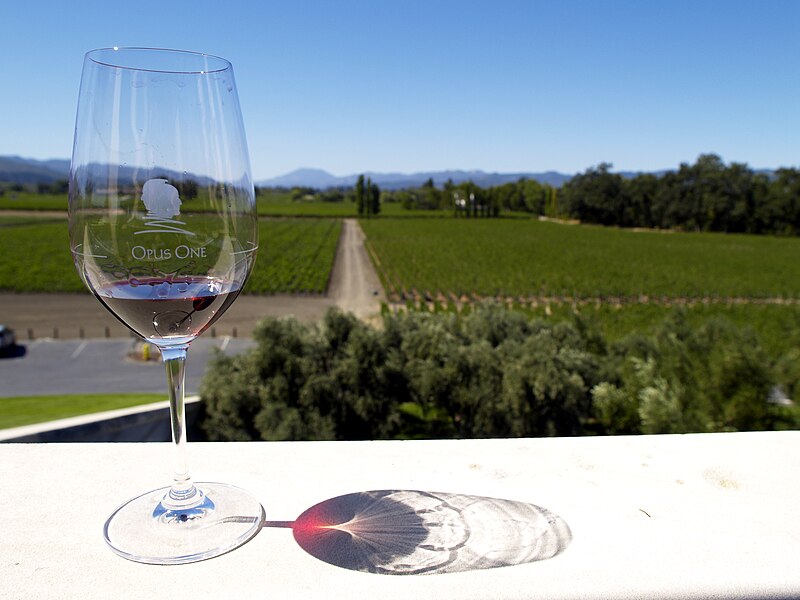
When you can buy 3 bottles of Canon-la-Gaffelière for the price of 1 bottle of Opus One and get something of very similar style and quality (if not better), it’s a no-brainer for me.
As I noted in my review of Clos de l’Oratoire’s 2017 futures offer, I find the style of Derenoncourt and von Neipperg to be very “New World-ish” so I always evaluate the pricing of their wines on the scale of equivalent priced Napa wines more so than other Bordeaux.
Compared to wines like Opus One, Stag’s Leap Wine Cellars, Silver Oak, Duckhorn and Caymus, I find that there is virtually no contest in the value that Derenoncourt and von Neipperg’s Bordeaux wines provide in delivering lush, hedonistic power for much more compelling prices.
And the wines always seem to be reliably approachable for early consumption. While, on the flip side, I tend to avoid buying Canon-la-Gaffelière and Clos de l’Oratoire in stellar vintages where I’m looking for more classic and age-worthy Bordeaux, these wines fit the bill perfectly for the “cellar defender” role I’m seeking out of vintages like 2017. That makes them an easy Buy, especially when the prices are right.
Ch. Canon (St. Emilion)
Some Geekery:
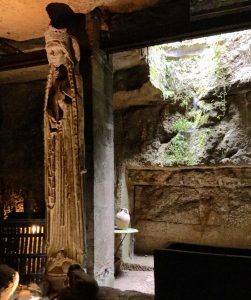
This photo was taken in the limestone caves of Beau-Séjour Bécot but through here you can access the caves of Ch. Canon which is only separated by a gated door.
Like neighboring Beau-Séjour Bécot, Ch. Canon was once an ecclesiastical vineyard ran by the monks of Clos St. Martin in the 1700s. It was during this period that much of the extensive limestone caves that still connect Beau-Séjour Bécot, Ch. Canon and Clos Fourtet were quarried out with the limestone used to build many chateaux in the Libournais.
The estate was known as Domaine de Saint-Martin in 1760 when it was purchased by Jacques Kanon, a privateer from Dunkirk who served as a lieutenant in the Royal Marines during the Seven Years’ War and earned his fortune from looting and piracy. However, the name of the domaine did not change to Ch. Canon until 1853 when it was owned by the descendants of Raymond Fontemoing who purchased Domaine de Saint-Martin from Kanon in 1770.
The Fontemoing family already owned the famous Chateau Canon in the Canon-Fronsac area which Clive Coates notes in Grand Vins was fetching the highest wine of any Libournais wine in the late 18th century.
The Fontemoings wanted to avoid confusion between their two properties and kept them separate until the wines of St. Emilion began earning more prominence on the market. By the mid 1850s, the newly rechristened Ch. Canon was ranked among the top 4 estates of St. Emilion alongside Ausone, Belair and Magdelaine.
The modern history of Ch. Canon was kick started in 1996 when the estate was sold by the Fournier family to the Wertheimer brothers, Alan and Gerard, who owned the luxury brand Chanel. Today it is part of a portfolio that includes the Margaux 2nd Growth Rauzan-Ségla, Ch. Berliquet in St. Emilion and St. Supéry in Napa Valley as well as the negociant firm Ulysse Cazabonne.
Under the Chanel Group’s ownership, significant capital was invested into replanting the vineyards and renovating the cellars. John Kolasa was brought on to manage Ch. Canon (as well as the other Bordeaux estates) where he stayed till 2015 when he was succeeded by Nicolas Audebert who formerly managed the LVMH Argentine project of Cheval des Andes. Thomas Duclos was also brought on that year as a consultant.

The vineyards of Ch. Canon.
The vineyards of Ch. Canon are smack dab in the heart of St. Emilion’s famous limestone plateau with additional parcels on the slopes neighboring Angelus and Ch. Quintus. In recent years, the owners have acquired Chateau Matras and Chateau Cure Bon with the INAO permitting some of the hectares from Cure Bon to be used in the Grand Vin.
The 2017 vintage is a blend of 73% Merlot and 18% Cabernet Franc. Around 6,000 cases a year are produced.
Critic Scores:
94-96 WA, 93-96 WS, 94-95 JS, 93-95 WE, 92-94 VM, 94-97 JD, 94-96 JL
Sample Review:
Another successful year for Canon; not as voluptuous as in 2016 or 2015, but it has a wonderful salinity and a crisp, fresh curl to the fruit. They aim for crystalline flavours, vibrant fruit and a sense of forward motion, and for me it has that again this year. The flavours of blueberries, blackberries and soft, smoky almonds are drawn out through the palate, and by the time it has finished you are ready to go again. It has an austerity that is overridden by the juice, not quite overriding the vintage, but it’s a delicious wine that again showcases the beauty of limestone. 50% new oak. Thomas Duclos is consultant here, and it really is a great year for the estates that he works with. (94 points) — Jane Anson, Decanter
Offers:
Wine Searcher 2017 Average: $94
JJ Buckley: $95.94 + shipping
Vinfolio: $96.00 + shipping
Spectrum Wine Auctions: $581.94 for minimum 6 bottles + shipping
Total Wine: $94.97
K&L: $94.99 + shipping
Previous Vintages:
2016 Wine Searcher Ave: $153 Average Critic Score: 95 points
2015 Wine Searcher Ave: $271 Average Critic Score: 96
2014 Wine Searcher Ave: $91 Average Critic Score: 92
2013 Wine Searcher Ave: $66 Average Critic Score: 91
Buy or Pass?
I’ve never been very impressed with John Kolsa’s style at Ch. Canon (or Rauzan-Ségla for that matter) so this is an estate that is usually not on my radar. I will say that the 2014 Canon was intriguing at the 2017 UGC Bordeaux tasting though. Given that that year’s wine was finished and bottled by Audebert and Duclos, I may have reason to give Canon another look.
But 2017 is not a vintage I’m using for revisiting or taking flyers on new estates and winemaking teams. Looking at the price history of the last 4 vintages of Canon, I won’t deny that there is clearly value here in the 2017 pricing and I can see this being a very compelling offer for other Bordeaux fans. I’m just more incline to be cautious which is leading me to Pass on buying this as a future.
Ch. La Dominique (St. Emilion)
Some Geekery:
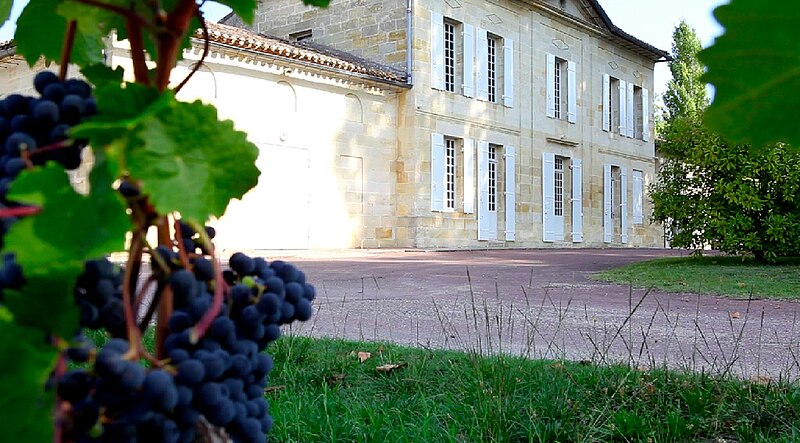
Ch. La Dominique
Ch. La Dominique is named after the Caribbean island of Dominica where the estate’s 18th century owners also had property.
The modern history of the estate began in 1933 when it was purchased by the de Bailliencourt family who own Ch. Gazin in Pomerol. The de Bailliencourts sold La Dominique in 1969 to billionaire Clément Fayat who made his fortune in the construction industry. Today it is part of a portfolio that includes Ch. Clément-Pichon in Haut-Médoc and Ch. Fayat in Pomerol.
In 2007, Fayat brought in Jean-Luc Thunevin (of Château Valandraud fame) to consult. He also purchased nearby Ch. Vieux Fortin, merging their 5 hectares of vines into La Dominique’s holding. The estate is experimenting with biodynamic viticulture.
Located in the western end of St. Emilion on the border with Pomerol, La Dominique has exceptional terroir neighboring Cheval Blanc and Ch. Figeac in St. Emilion as well as La Conseillante and L’Evangile across the way into Pomerol. From the rooftop of their restaurant, La Terrasse Rouge located among their vineyards, you can see the vineyards of Ch. Petrus as well.
The 2017 vintage is a blend of 70% Merlot, 20% Cabernet Franc and 10% Cabernet Sauvignon. Around 7000 cases a year are produced but with significant frost damage experienced in 2017, production this year is likely closer to 3500 cases.
Critic Scores:
92-94 WE, 92-93 JS, 90-93 WS, 89-91 VM, 91-93 JL
Sample Review:
70% frosted so they had more Cabernet Sauvignon (10%) and Cabernet Franc (20%) in 2017. This is 50% of production. Inky dark with purple rim. Dark, rocky/mineral fragrance. Juicy and scented on the palate, with some red as well as black fruit. Super-polished tannins that are a fine framework for the fruit. Refined, not over-oaked. Long. (17/20 points) — Julia Harding, JancisRobinson.com
Offers:
Wine Searcher 2017 Average: $57
JJ Buckley: No offers yet.
Vinfolio: No offers yet.
Spectrum Wine Auctions: No offers yet.
Total Wine: $59.97
K&L: No offers yet.
Previous Vintages:
2016 Wine Searcher Ave: $62 Average Critic Score: 92 points
2015 Wine Searcher Ave: $58 Average Critic Score: 92
2014 Wine Searcher Ave: $51 Average Critic Score: 91
2013 Wine Searcher Ave: $41 Average Critic Score: 89
Buy or Pass?
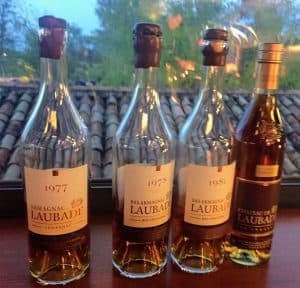
The restaurant also had a killer collection of vintage Armagnacs.
Visiting the vineyards of La Dominique and their La Terrasse Rouge restaurant was one of the highlights of my 2016 Bordeaux trip. This site truly has remarkable potential but not a single one of their wines really left any kind of impression.
While I adore Thunevin’s work at his own personal estate of Valandraud and his consulting work at Fleur Cardinale, I have a hankering suspicion that the business goals of La Dominique are more geared towards tourism than necessarily raising the quality of their wines above other Grand Cru Classé. And with pricing closer to 2015/2016 levels than 2014 this is an easy Pass for me.
More Posts About the 2017 Bordeaux Futures Campaign
*Bordeaux Futures 2017 — Langoa Barton, La Lagune, Barde-Haut, Branaire-Ducru
*Bordeaux Futures 2017 — Pape Clément, Ormes de Pez, Marquis d’Alesme, Malartic-Lagraviere
*Bordeaux Futures 2017 — Lynch-Bages, d’Armailhac, Clerc-Milon and Duhart-Milon
*Bordeaux Futures 2017 — Clos de l’Oratoire, Monbousquet, Quinault l’Enclos, Fonplegade
*Bordeaux Futures 2017 — Cos d’Estournel, Les Pagodes des Cos, Phélan Ségur, Calon-Segur
*Bordeaux Futures 2017 — Clinet, Clos L’Eglise, L’Evangile, Nenin
*Bordeaux Futures 2017 — Malescot-St.-Exupéry, Prieuré-Lichine, Lascombes, Cantenac-Brown
*Bordeaux Futures 2017 — Beychevelle, Talbot, Clos du Marquis, Gloria
*Bordeaux Futures 2017 — Vieux Chateau Certan, La Conseillante, La Violette, L’Eglise Clinet
*Bordeaux Futures 2017 — Montrose, La Dame de Montrose, Cantemerle, d’Aiguilhe
*Bordeaux Futures 2017 — Clos Fourtet, Larcis Ducasse, Pavie Macquin, Beauséjour Duffau-Lagarrosse
*Bordeaux Futures 2017 — Kirwan, d’Issan, Brane-Cantenac, Giscours



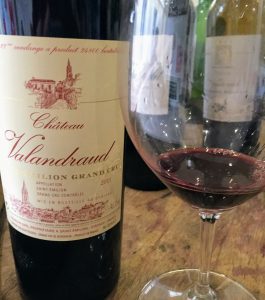

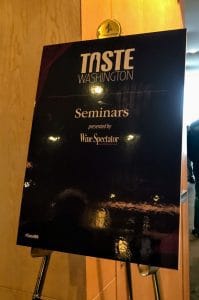 Every year as part of
Every year as part of 